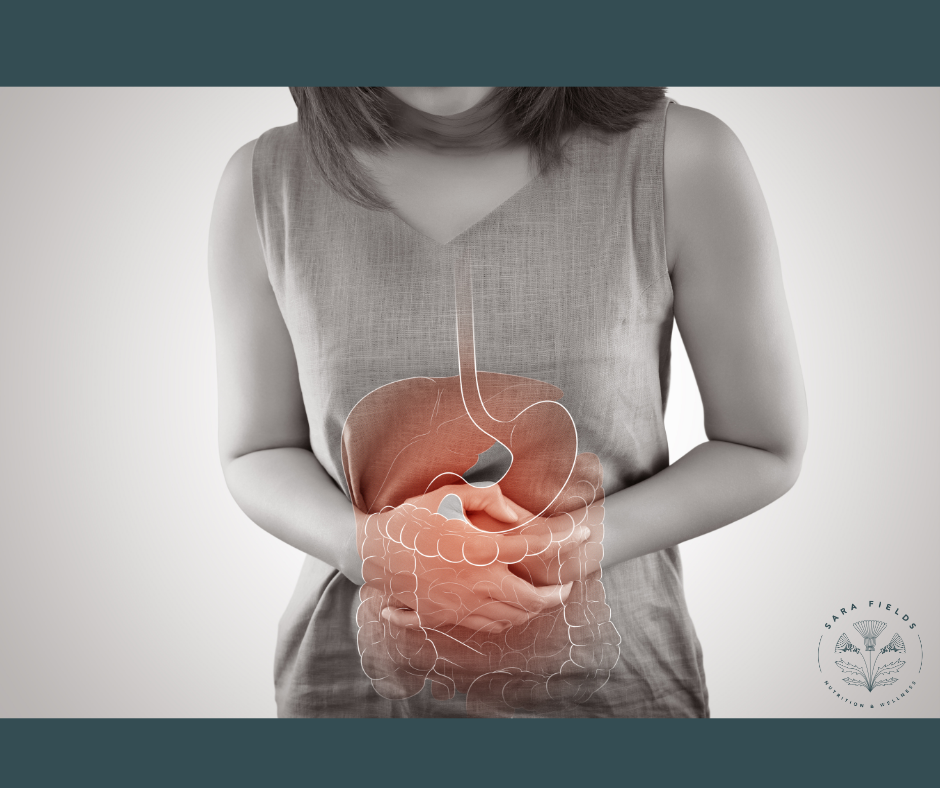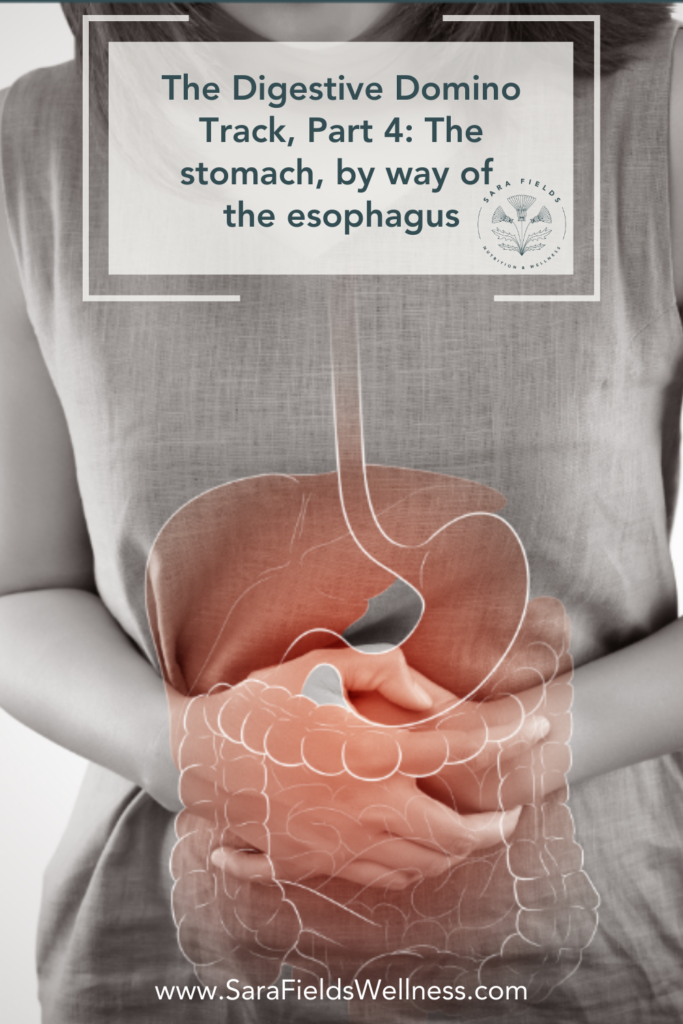
By now in this series of digestive domino track posts, you’re likely getting the idea. One thing triggers the next, and if you have symptoms in one area, you not only have to look back upstream to understand where things might have gone off course, but you also have to look downstream to understand how that could impact what’s going on throughout the rest of your digestive system.
Say it with me – nothing in the digestive system happens in isolation!
For this edition of our digestive deep dive, we’re starting to get into the good stuff. And when I say the good stuff, I mean we’re really uncovering the sites of dysfunction that are the most common drivers of your pesky digestive symptoms.
So for all my people out there with acid reflux, indigestion, GERD, or with a history of ulcers, this one’s for you. If your digestive symptoms lie further down – bloating, constipation, diarrhea, etc. – this is also for you because… well, see paragraph one! 😉
What Does the Stomach Do?
Your stomach, that pouch nestled snugly in your abdomen, is responsible for churning, mixing, and smashing up your food into a concoction called chyme. This allows your food to reach the point of being nearly fully digested by the time it moves into the small intestine, which is the next domino in the track. The stomach facilitates this chemical digestion with the help of digestive juices – enzymes and acids produced by the cells of the stomach. These break down proteins, fats, and carbohydrates into smaller, more manageable pieces, which is really important because this allows them to actually be absorbed and put to good use. A big detail here is that the stomach must be acidic enough to carry out this important chemistry experiment!
Where can things go wrong? And what does this have to do with my acid reflux?
Contrary to popular belief, the stomach is rarely too acidic. In fact, the opposite problem is often behind the uncomfortable sensations of acid reflux and indigestion.
When the pH of the stomach doesn’t get low enough (ideally between 1.5 and 3), because of a decrease in those digestive juices, the acidic contents of the stomach stay in there too long. This partially digested substance begins producing gasses – kind of like a fizzy bottle of kombucha – and this pressure can cause the contents to push up on the esophageal sphincter (the muscle that closes off the esophagus from the stomach). As a result, not only might you burp or belch to release some of this gas, but those acidic contents might reflux up into the esophagus. So you can see how it’s less about there being too much acid in the stomach, and more about it getting to the wrong place. The esophagus is not meant to have acidic contents in it! It is designed to have a neutral pH of around 7. The stomach is the only place in the body that’s designed to have such a low pH!
So not only does this issue in the stomach cause digestive symptoms upstream, but when that stomach pH doesn’t get low enough, it also doesn’t trigger the pancreas or the gallbladder to do their very important jobs downstream. More on that in the next post in this series!
But why does this happen? What prevents the optimal production of those acidifying digestive juices?
- Nutrient deficiencies, particularly zinc, can prevent us from producing enough hydrochloric acid (the type of acid in the stomach). Additionally, a diet low in protein can downregulate the digestive production of gastric juices, which prevents optimal digestion.
- Other dietary factors like alcohol and excessive carbohydrate intake can also contribute to a reduction in digestive juices. Anecdotally, my clients share that they’re more likely to experience acid reflux or indigestion symptoms from a high carb meal than spicy foods! Now, obviously this is different for everyone, but it’s interesting that the common culprits of these symptoms (spicy or acidic foods) are often less problematic than carbohydrate-rich foods.
- Lifestyle factors that increase stress (remember that the brain is the #1 domino!) are a huge culprit behind reduced digestive output. Even potentially fun stressors like travel can throw things off. Likewise, simply getting older is a factor in waning digestive juices.
- Lastly, a common culprit behind dysfunction in the stomach is a pesky bacteria called H.pylori. This microbe burrows its way into your stomach lining, damaging those very cells that produce the digestive juices. Not only can this trigger inflammation and those acid symptoms, but in more extreme cases it can contribute to the development of ulcers and even gastric cancer.
So what do we do about it?
Surprise, surprise! Some of these things you’ve already read about in Part 2 and Part 3 of this series.
- First things first, try to help your body get into a relaxed state before eating your meals. You can do this by taking deep breaths, sitting somewhere quiet, removing distractions, not eating on the go, and avoid stressors while eating (hello, nightly news!).
- Slow down and chew your food thoroughly. Not only does this trigger the production of those digestive juices, but chewing also helps with the chemical digestion process in the stomach by breaking food down into small pieces before it gets there. Ever notice that when you’re rushing or inhaling your food, you often don’t feel so great afterward? This is why!
- Give your stomach some downtime between meals, and ideally avoid snacking. There are cases where eating something every few hours might make sense, but for those with balanced blood sugar levels and stable energy, giving at least 4 hours or so between meals is best. This allows your digestive system to initiate a sort of internal housekeeping process called the migrating motor complex. This helps to move contents out of the stomach and onward in the digestive process and control bacterial growth in the intestines. Anytime we eat, we stop this process.
- Consider your use of acid reducing medications. While these help to alleviate the symptoms temporarily, they could potentially be fueling the problem by reducing hydrochloric acid and increasing the stomach’s pH. Now, of course, if you’re on a prescription medication, that’s something to discuss with your doctor and I’m NOT advocating anyone stop their meds without consulting with their physician! It is worth a conversation, however, about the intended length of time for you to be on the medication, as they’re not intended for long-term use and prolonged use can contribute to nutrient deficiencies, decreased bone strength, and potential increased susceptibility to bacterial infections.
- Lastly, you might benefit from supplemental hydrochloric acid. I use this with nearly every client in my practice! It’s something I consider to be a foundational supplemental support, as it’s one of the most effective ways to encourage optimal digestion and the subsequent absorption of nutrients. And when there are upstream and downstream impacts of low stomach acid – burping, acid reflux, bloating, irregular bowel movements, etc. – this can be a game-changer!
So there you have it – the stomach – a powerhouse organ of the Digestive Domino Track! It and its acid are not the villains they’ve been made out to be after all. We need stomach acid for optimal digestion and to eat and enjoy our meals symptom free.
In the next post, we’ll talk all about how that good food goes on to fuel our bodies when we discuss the small intestine.

leave a comment